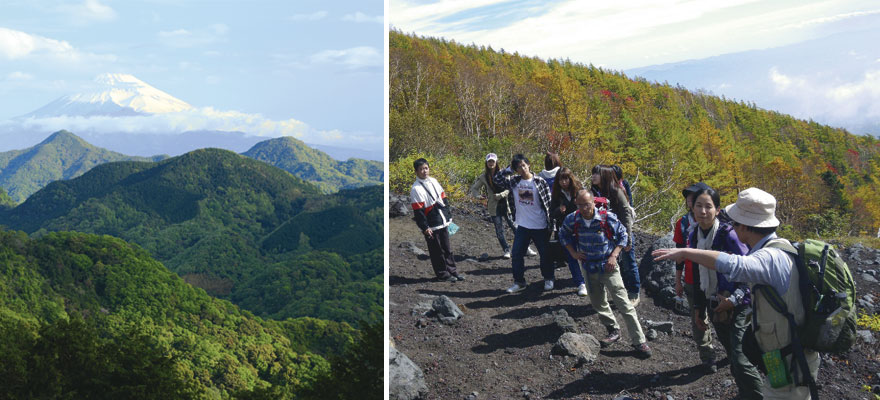Home > Highlighting JAPAN > Highlighting Japan September 2013 >Mount Fuji, World Heritage Site
Highlighting JAPAN
Mount Fuji: World Heritage Site
Protecting the Outstanding Universal Value of Mount Fuji
Environmental and Conservation Efforts in the new UNESCO World Heritage Site

Mt. Fuji is a very popular destination for visitors from home and abroad. On the other hand to reduce the mischief brought by climbers and tourists, a durable conservation plan to protect the environmental integrity of the Mt. Fuji region is required. Suitable control and protection of the mountain is requested.
During the two-month climbing season in the summer, approximately 300,000 people climb the peak. The mountain has many man-made facilities, such as lodges for hikers to stay overnight, rest stops where the weary can take a drink break, restaurants for refreshments and even a bulldozer that is used to maintain the trails, whereas the surrounding areas have many conveniences built for tourism, including golf courses, hotels, ski runs and, of course, hiking trails. It is rather unique that even a mailbox is put up on top of the Mt. Fuji during the months of July and August so that the climber can send the postcard to their friends and families. With the new World Heritage designation, however, even more tourists are anticipated in the future and one of the primary concerns of UNESCO is how to properly balance the conservation efforts of the area with the renewed interest in Mt. Fuji as a visitor destination. Local, prefectural and national governments are now coordinating efforts to conserve historic and cultural sites while also facilitating access to travelers to the region.
To protect the integrity of the mountain itself, the Prefectural governments of Yamanashi and Shizuoka passed the "Fuji Charter" in 1998 which became the origin of the national movement to instate Mt. Fuji as a Japanese symbol which Japanese are proud of. Today, however, the obligation is to protect not only the ecology of the mountain, but the various historical and natural sites in the environs surrounding Mt. Fuji that presently falls under various jurisdictions.
For the conservation of Mt. Fuji and the surrounding area as a world heritage, the "Mt. Fuji comprehensive conservation plan" was established. At the same time "Mt. Fuji cultural heritage council" was constituted for the preservation of the property and the vicinity surely. This involves the cooperation of many government ministries and levels, including the Ministries of the Environment, Cultural Affairs, Defense, Forestry and Infrastructure, Transport and Tourism as well as the Prefectural governments of Shizuoka and Yamanashi and their various city councils. Some residents, asset holders, concerned affiliates are the member of the sectional meetings which regulate the council. An academic committee has also been formed to assist investigations and counsels.
The upper reaches of Mt. Fuji has been designated as a special protection zone of the national park in order to offer the highest degree of natural conservation possible. For example, in the Shizuoka prefecture, the "Mt. Fuji Eco-Rangers" which is organized by local volunteers can offer guidance and lectures relating to hiking manners, the Fuji Charter and the abundant natural wildlife. Representatives of the Shizuoka Prefecture's Group for Environmental Protection of Mt. Fuji, Bureau of the Environment, state that "Now that Mt. Fuji has been designated as a World Heritage Site, it will become even more imperative to protect and preserve the natural environment. For this reason, expectations are high to start some environmental initiatives in the area." Moreover, road signs and interpretation boards are being installed in four languages (Japanese, English, Chinese, and Korean) and new thematic hiking courses at the lower reaches of the mountain have been assigned according to the interests of visitors.
Since Mt. Fuji is a volcano, the ground changes to sand and lava detritus beyond the 2500 meter point, but the surrounding foothills are lush in flora and fauna. The water on Mt. Fuji is well known for its clarity, freshness and invigorating coolness, and hikers passing streams and wells can enjoy drinking it as a refreshment. The water not only supports trees and vegetation, but also the many deer, bears, mountain goats and tanuki (racoon-dog) and also a variety of butterfly and bird species that thrive in the forests and fields as well. Currently, several scientific stations have been established to study wildlife in the area, including an international fieldwork survey of butterflies as a measure of ecosystem health.
Mt. Fuji is a masterpiece of earth orogenic movements. The registration of this sacred mountain as a world cultural heritage means the original Japanese valuejudgemnt of nature and culture which finds out spirituality, artistry and religionality in nature itself was recognized internationally. The registration isn't a goal but a new start to keep this mountain. The effort such as, environment conservation, security of the climbers, accepting visitors, all links to the succession to the mountain surely to the future generation is the essential challenge.
© 2009 Cabinet Office, Government of Japan






